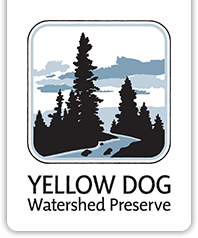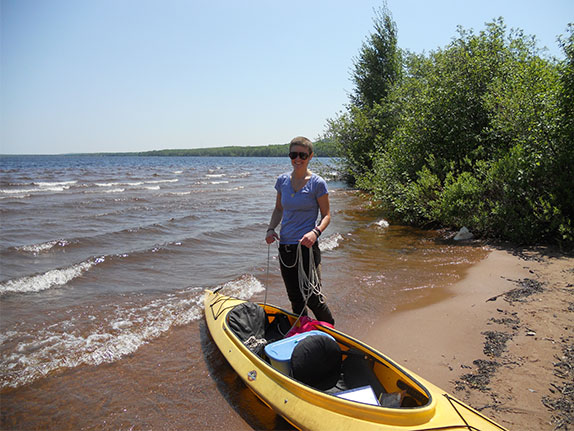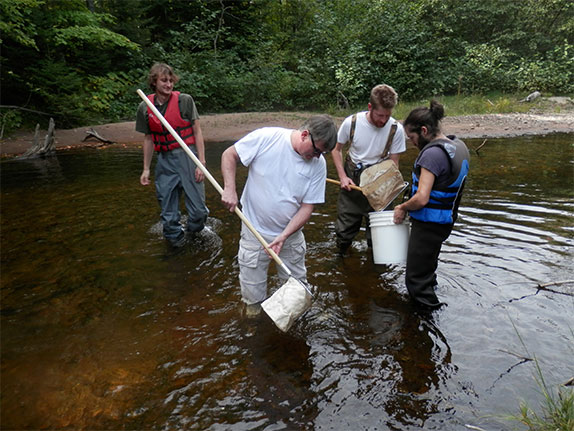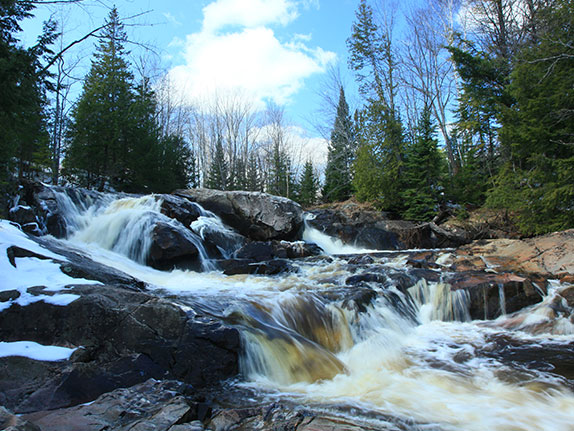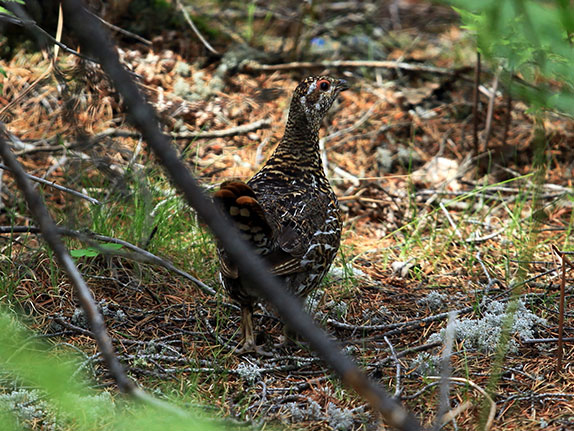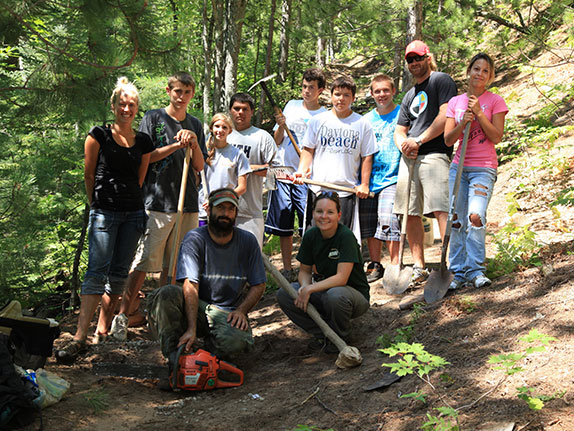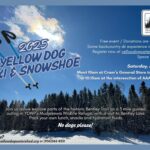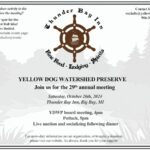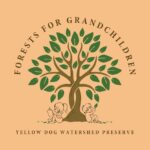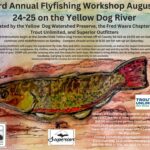
Mudjekewis
Wildlife Refuge

As of April 2019, the Yellow Dog Watershed Preserve became the permanent caretakers and owners of 1,000 acres of land on the Yellow Dog Plains in Michigamee Township. Called the Mudjekewis Wildlife Refuge, the land is to be protected forever as a place to inspire the community to interact with nature in a quiet and thoughtful manner. The property is the gift and legacy of Fred and June Rydholm and their family. We undertake this task with reverence for both the people that spent so many years creating this mosaic of land and for the land itself. From the beginning, Fred and June’s vision for the land included environmental stewardship, education, inspiration, and historic preservation.

History and Background
The word Mudjekewis is rooted from the Anishinaabe language and it appears in the Song of Hiawatha by Henry Wadsworth Longfellow. In the Tribe’s mythology, Mudjekeewis (from the word majiikiwis meaning “first-born son”) is a spirit and featured in their stories, including the lore of the creation of the world. Majiikiwis is the son of the E-bangishimog, the West Wind, and is the guardian of tradition and ceremonies, often symbolized by the bear.
Fred Rydholm’s interest in these lands was sparked when he heard stories while working at the Huron Mountain Club in the 1940s. Fred first laid eyes on the ruins of the Arbutus Lodge some time in the late 1940’s and he became captivated by its story of old-money industrialists finding retreat in the wilderness of the Yellow Dog Plains. As he learned more, he knew he had to claim a piece of that story and so purchased the site, including the remnants of the lodge and guide house, in 1949. Over time, he continued to add more land to this original purchase until his family became stewards of 1,000 acres. Most of the land has been owned by the Rydholm family for nearly 75 years, under Fred’s philosophy of thoughtful stewardship with a view toward the preservation and protection of the area’s wild character. Fred and June strongly believed that these lands deserved permanent protection.

The Rydholms also dreamed of fostering recognition of the land’s historic value. The property features a camp on the Bentley Trail, a 30 mile long hiking trail that led from the Huron Mountain Club to the “Grand Camp” of American industrialist Cyrus McCormick (now the federally protected McCormick Wilderness Area). That trail was constructed and maintained by a crew of laborers, including Nels, Jim, and Christ Andersen, who were immigrant homesteaders on the Yellow Dog Plains. The sand plains became the site of a “Halfway Cabin” or resting point (also called “Sand Plains Cabin” and “Arbutus Lodge”) where guests of the Huron Mountain Club and the McCormicks often spent several nights during their hike. Fred spent decades of his life documenting the personalities and places associated with the Bentley Trail, as well as its various intersections with the region’s rich cultural heritage. The Mudjekewis Lands have a storied past, well-documented in Fred’s book, Superior Heartland: A Backwoods History (1989).
Landscape Character
The landscape of the Mudjekewis Wildlife Refuge can be described as an area within the Yellow Dog Plains, itself a sandy region of glacial outwash forested by jack pines, ferns, lichens, mosses, and blueberries. First surveyed by W. A. Burt and sons in the 1840s, the Yellow Dog Plains were marked “Sand Plaine”; later topographic maps added the ponds. Located in the Michigamme Highlands, the Mudjekewis lands form a greenway, connecting interior wilderness lands with the shoreline of Lake Superior. The land, having been historically logged, swept by fires and generally considered worthless, were gathered together, replanted, reconnected, and start its journey to return to its natural condition by the Rydholms.
The property includes a variety of natural communities including jack pine barrens, northern meadows, vernal pools, spring fed ponds, Bentley Lake, and headwater wetlands. Freshwater forested shrub/wetlands play a prominent ecological role as they feed the Yellow Dog River and specifically, the rich conifer swamps interspersed with isolated upland islands which provide a great diversity of habitats for birds, mammals, and plants.
Fred referred to the Yellow Dog Plains as a “jack pine ecotone” where the species grows “taller, bigger, straighter and older than anywhere else.” He related a theory, shared with him by a biologist, that jack pine of the Yellow Dog Plains could possibly represent an ancient hybrid of lodgepole and jack pine. The P. contorta X banksiana theory would certainly help explain the vigorous and unusually arrow-straight growth of the local jack pine. Whether ecotone, habitat, genotype or hybridization, the Michigan Department of Natural Resources now recognizes the importance of replanting state lands with locally-gathered seed, because seed-grown jack pine nursery stock from elsewhere, planted on the Yellow Dog Plains, often fails to thrive.
Recent plant surveys yielded over 80 species throughout the varied natural communities. In addition, bird surveys resulted in the identification of at least 52 distinct species including the Black-backed Woodpecker, Kirtland’s Warbler, Boreal Chickadee, Tennessee Warbler, and American Bittern. The Mudjekewis lands support wide-ranging species such as wolves and moose, and are home to black bear, whitetail deer, fishers, martens, red fox, and coyotes. Bentley Lake is a beaver-engineered system and a refuge for riparian species and migratory waterfowl. The Bentley Ponds support turtles, salamanders, snakes, migratory songbirds, and diverse invertebrate populations.

Long Term Protection
Keeping the land in its natural condition and preserving the historical value is a top priority. YDWP’s objectives as caretakers include reducing fragmentation of larger landscapes, increasing biodiversity of forests on the Plains, and protection of critical freshwater resources for wildlife and ecosystem health.
This landscape has so much to offer posterity in the form of a healing wilderness, a place to step away from the modern world, and place marker of days gone by. YDWP will manage the property according to best ecological practices as well as the intent of the people who spent their lives building this legacy. Certain human activities will be prohibited including
- Commercial Forestry
- Hunting/Trapping
- Motorized Vehicle Use
- Industrial/Commercial Activities
- Mining
Activities that will be promoted focus on incorporating low impact activities for the public to engage with the landscape. Silent sport recreational activities such as hiking, skiing, snowshoeing, birding, and photography will be supported. In addition, the intent is to incorporate the arts. In the future, there may be opportunity to create artist-in-residence programs.
At this time, it is important to note that the family will continue to use 80 acres that include the ponds and cabins. Please respect their rights and refrain from entering that area. See map for details on this location.
YDWP will ensure that the notion of Leave No Trace remains at the forefront. Please visit this special place and leave it just as you found.
A Community’s Gratitude

YDWP is honored to be the permanent caretakers of this land. We continue to strive to keep the watershed in its most natural state for present and future generations and this project fits precisely within our mission. We also want to acknowledge the generosity and intent of all who made this project possible.
The Rydholm family has made a remarkable effort in the protection of our wild spaces. Fred spent his life re-assembling the parcels that were once fragmented and sold off to recreate an entire landscape. The donation of this land to posterity should serve to inspire others into ideas and actions that will help heal the planet, from which we are given everything. In addition, we want to thank our anonymous donors who helped fund the execution of this project. There were many expenses to cover to ensure this land is protected to the highest level in perpetuity and these guardian angels made it happen in a serendipitous fashion. Lastly, the Upper Peninsula Environmental Coalition provided the initial start up grant for the project. We very much appreciate their confidence and support. To all of who made this project a reality, please accept our deepest gratitude.
If you wish to be a part of this project, you can support it financially by making a donation to our Land Protection Program. You can also help be part of the long term monitoring of our lands by volunteering for our Volunteer Land Monitoring Program. Whatever you do, let the intent of this project help you to help heal our wild lands.

